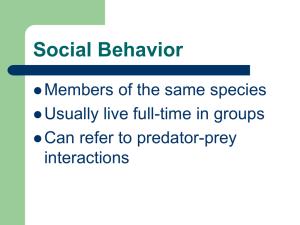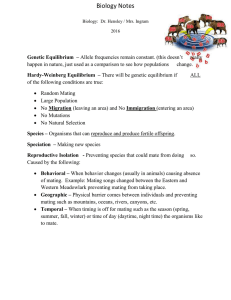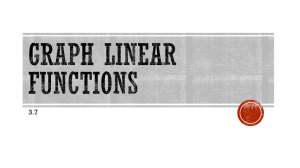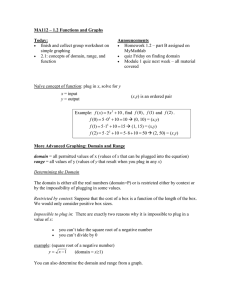Chemistry of a Mating Plug in Bumblebees
advertisement
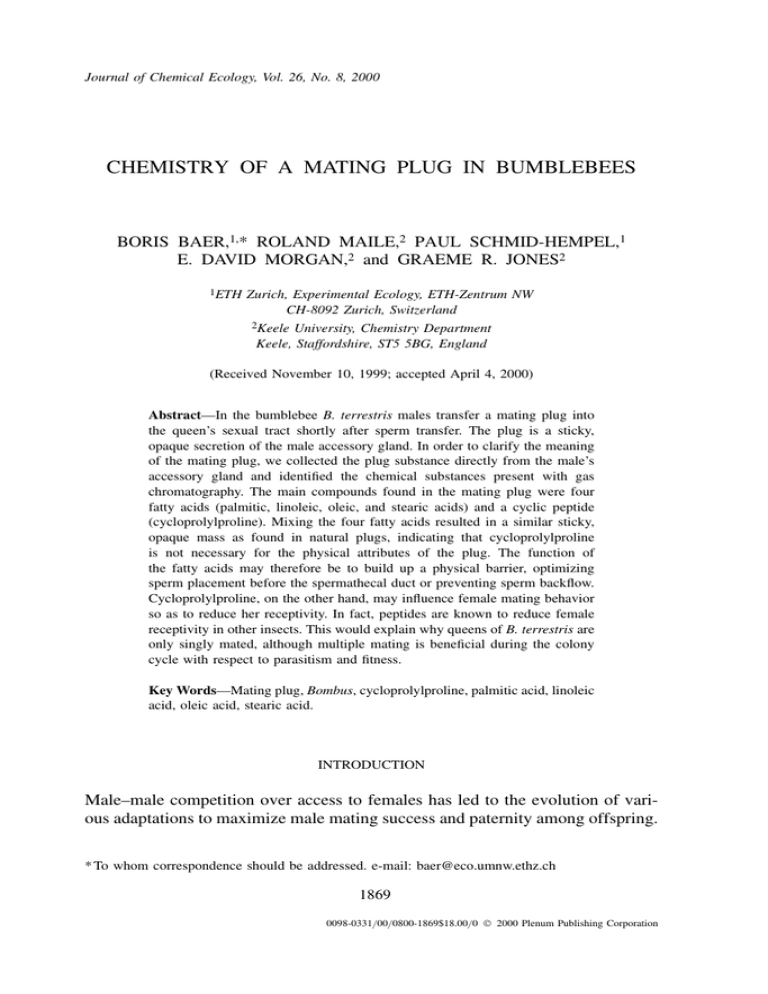
Journal of Chemical Ecology, Vol. 26, No. 8, 2000 CHEMISTRY OF A MATING PLUG IN BUMBLEBEES BORIS BAER,1,* ROLAND MAILE,2 PAUL SCHMID-HEMPEL,1 E. DAVID MORGAN,2 and GRAEME R. JONES2 1ETH Zurich, Experimental Ecology, ETH-Zentrum NW CH-8092 Zurich, Switzerland 2Keele University, Chemistry Department Keele, Staffordshire, ST5 5BG, England (Received November 10, 1999; accepted April 4, 2000) Abstract—In the bumblebee B. terrestris males transfer a mating plug into the queen’s sexual tract shortly after sperm transfer. The plug is a sticky, opaque secretion of the male accessory gland. In order to clarify the meaning of the mating plug, we collected the plug substance directly from the male’s accessory gland and identified the chemical substances present with gas chromatography. The main compounds found in the mating plug were four fatty acids (palmitic, linoleic, oleic, and stearic acids) and a cyclic peptide (cycloprolylproline). Mixing the four fatty acids resulted in a similar sticky, opaque mass as found in natural plugs, indicating that cycloprolylproline is not necessary for the physical attributes of the plug. The function of the fatty acids may therefore be to build up a physical barrier, optimizing sperm placement before the spermathecal duct or preventing sperm backflow. Cycloprolylproline, on the other hand, may influence female mating behavior so as to reduce her receptivity. In fact, peptides are known to reduce female receptivity in other insects. This would explain why queens of B. terrestris are only singly mated, although multiple mating is beneficial during the colony cycle with respect to parasitism and fitness. Key Words—Mating plug, Bombus, cycloprolylproline, palmitic acid, linoleic acid, oleic acid, stearic acid. INTRODUCTION Male–male competition over access to females has led to the evolution of various adaptations to maximize male mating success and paternity among offspring. * To whom correspondence should be addressed. e-mail: baer@eco.umnw.ethz.ch 1869 0098-0331/ 00/ 0800-1869$18.00/ 0 2000 Plenum Publishing Corporation 1870 BAER ET AL. For example, during mating males may transfer not only sperm, but also chemical substances into the female’s sexual tract, which increase the likelihood of paternity (male mating success) (Price et al., 1999; Gonzalez et al., 1999; Soller et al., 1997). Such chemical compounds are produced in the male accessory gland of insects (Gillott, 1996). They are known to induce behavioral and physiological changes in mated females (Wolfner, 1997; Yi Shu and Gillott, 1999). In some insects compounds from the male accessory gland form a mating plug or part of a mating sign, which are reported to have different functions; such plugs or signs inhibit further matings (Polak et al., 1998; Dickinson and Rutowski, 1989; Monnin and Peeters, 1998), prevent sperm from flowing out of the female’s sexual tract (Woyciechowski et al., 1994), ensure the paternity of the last male (Lachmann, 1998), retain sperm near the opening of the sperm storage (Polak et al., 1998), or serve as a biochemical signal influencing femaleto-male behavior (Monnin and Peeters, 1998). Mating success in social insects is especially interesting. In particular, whether one or several males succeed in mating with a single queen affects the average relatedness among workers in the colony. This leads to variation in a number of key parameters of sociality, such as the level of cooperation (Keller and Reeve, 1994) or sex allocation to offspring (Boomsma and Grafen, 1990). For the social Hymenoptera (bees, ants, and wasps) information on female (queen) mating behavior is available, but male reproductive skews, i.e., sperm bias, are poorly investigated including the function and biology of the male accessory gland. Given the observed variation in female mating frequency and sperm bias (Boomsma and Ratnieks, 1996), more information is needed about the function and the biochemistry of these compounds in social insects. This could help in understanding recently discussed topics such as the observed differences in queen mating frequencies among females and among taxa. Queens of B. terrestris appear to be singly mated in Central Europe (Schmid-Hempel and Schmid-Hempel, 2000). They also often refuse to remate in flight cages (personal observation), although queens would benefit from multiple mating by higher fitness and lower parasite loads (Baer and Schmid-Hempel, 1999). Therefore, queens do not take advantage of the benefits of multiple mating. Male bumblebees may control queen mating frequency, for example, by transferring chemical compounds that influence the queen’s mating behavior. This idea is supported by the observation that bumblebee males transfer a mating plug into queens shortly after sperm transfer. The plug is a gelatinous secretion of the male accessory gland and forms a characteristic, sticky mass in the queen’s bursa copulatrix. The plug remains in place for several days and could potentially act as a sperm barrier (Duvoisin et al., 1999). Here we have identified the chemical compounds of the plug. MATING PLUG CHEMISTRY OF BUMBLEBEES 1871 METHODS AND MATERIALS Colonies of B. terrestris were reared in the laboratory from queens caught in spring 1998 around Zürich, Switzerland. The colonies were kept in climate chambers in red light at 268 C and 60% humidity and were fed ad libitum with pollen and sugar water. To avoid measuring chemical compounds of the female’s sexual tract rather than those from the male, we extracted the secretion that forms the plug directly from the male accessory gland instead of dissecting freshly mated queens. The males were removed from the colonies shortly after eclosion, kept in brother groups in plastic boxes (14 × 18 × 10 cm) and were fed ad libitum with pollen and sugar water. Males of B. terrestris normally mate at an age of 16 ± 7 days (Duchateau and Marien, 1995). For practical reasons, we used males of an approximate age of 10 days for our experiments. Identification of Plug Compounds by Gas Chromatography. To collect the plug secretion, males were killed with CO2 . The abdomen was opened and the accessory gland as well as the ejaculatory duct and the endophallus were removed and washed in insect Ringer. With this procedure, the accessory male gland secretion (i.e., the plug) starts to leak out of the endophallus and forms a typical white, opaque mass that can be picked up with a fine insect needle and transferred into a glass capillary (1.6 mm diam.). The capillary was sealed by melting both ends and was used directly for gas chromatography. To verify the presence and concentration of plug compounds, we later synthesized a plug using commercially available chemicals in the same concentrations as found in the natural plug and repeated the chromatography. The analyses were carried out with a Hewlett Packard 5890 gas chromatograph directly coupled to a 5970B selective detector (quadrupole mass spectrometer, 70 eV electron impact ionization). The system was controlled and data accumulated on a Hewlett Packard series 300 computer with HP 5970C Chemstation. Mass spectra were scanned from m/ z 35 to m/ z 550. Scan time was about 2.4 sec. Chromatography was performed on an immobilized polydimethylsiloxane phase in a fused silica column (12 m × 0.2 mm, 0.33-mm film thickness) (SGE, Milton Keynes, UK). Helium was used as carrier gas at 1 ml/ min. The glass capillary containing the plug material was crushed inside the injector port. The oven was programmed from 308 C (3 min) at 88 C/ min to 2508 C. The split valve was closed before crushing the sample and reopened 30 sec later. Identification of compounds was confirmed by comparison of their mass spectra and retention times with those of standards and by comparison with MS databases. RESULTS The chromatograms of a single plug and the synthetic mixture of the compounds are shown in Figure 1a, 1b. Chromatograms of five natural plugs were BAER 1872 ET AL. FIG. 1. (a) Reconstructed total-ion chromatogram (TIC) of a GC-MS analysis from injection of the mating plug content of one Bombus terrestris drone by solid-sampling technique. 1: Cycloprolylproline; 2: palmitic acid, 3: linoleic acid, 4: oleic acid, 5: stearic acid. (b) Reconstructed chromatogram of a GC-MS analysis from injection of a synthetic plug of commercially available chemicals in similar concentrations as found in a natural mating plug of Bombus terrestris. practically identical. The identity of the compounds is given in Table 1. The main compounds detected in the five plugs were linoleic acid, followed by oleic, palmitic, and stearic acids. A cyclic dipeptide, cycloprolylproline was found in smaller amounts (Table 1). Mixing the four commercially available fatty acids (linoleic, oleic, palmitic, and stearic acids) at the same concentrations as found in natural plugs gave the same kind of sticky, opaque mass. Cycloprolylproline is obviously not necessary for the physical attributes of the plug. The synthetic plug containing the five substances detected produced a chromatogram similar to that of a natural plug. DISCUSSION Analyses of the chemical compounds in male accessory gland secretions of male bumblebees showed relatively few main components. The fatty acids 1873 MATING PLUG CHEMISTRY OF BUMBLEBEES TABLE 1. COMPOSITION OF MATING PLUGS REMOVED FROM MALES OF Bombus terrestries, TOGETHER WITH STANDARD DEVIATIONS (N c 5 Drones) 1 2 3 4 5 Compound Retention time (min) Cycloprolylproline Palmitic acid Linoleic acid Oleic acid Stearic acid 24.95 25.36 27.75 27.88 28.09 Mol. mass and (diagnostic ions) 196 256 280 282 284 (70, (43, (67, (55, (43, 98, 73, 41, 69, 73, 110) 60) 55, 81) 60, 83) 60) Mean proportion (ng/ plug ± SD) 230 980 5400 1700 440 ± ± ± ± ± 40 300 1000 750 290 detected (Table 1) are common biological substances and are known to be used in other social insects for communication purposes. For example, oleic and linoleic acid levels increase in dead ants and induce necrophoretic behavior in different ant species (Akino and Yamaoka, 1996). Other social insects such as wasps use these two fatty acids as predator (ant) repellents (Dani et al., 1996) where they also form a gelatinous mass. In general, fatty acids are common but minor components of insect cuticular lipids (Lockey, 1988). The ubiquitous presence of fatty acids in tissue means that caution must be used when ascribing a function to them. However, in this case, the fatty acids are found as a massive quantity. This is the first report of the combination of palmitic-, linoleic-, oleic, and stearic acids to be involved in insect reproduction. Since the fatty acids detected here have the potential to be a messenger, it would be very interesting to see whether males or queens use them in the organization of mating behavior, for example, to manipulate the readiness for copulation. Duvoisin et al. (1999) found that the plug persists in the queen’s sexual tract for several days indicating that it is not, or only slowly, absorbed by the queen. Additionally Duvoisin et al. (1999) demonstrated that the plug can act as a sperm barrier. Therefore, the main function of the fatty acids in the plug in the case of B. terrestris may be a physical barrier. Additionally, the plug may aid in the placement of sperm near the entrance to the queen’s spermatheca or aid in preventing sperm backflow. Both effects could help maximize a male’s paternity. Cycloprolylproline has never been reported before in social insects. As our analysis showed, this compound is not necessary for the physical properties of the plug. Many cyclic peptides, such as cycloleucylphenylalanine in the venom of the ant Pachycondyla (Cruz Lopez and Morgan, 1997) have very bitter tastes to humans (Matoba and Rata, 1972). However, cycloprolylproline is reported to have a flat taste (Ishibashi et al., 1988). While caution is necessary in extrapolating from human to insect senses, cycloprolylproline may have a role in sensory detection. Peptides are known from other insects to reduce receptivity in females (Chen et al., 1988), and cycloprolylproline may have the potential to act as a BAER 1874 ET AL. pheromone influencing the mating behavior of queens, and in particular reducing her receptivity. This should substantially increase a male’s reproductive success at the expense of competitors since bumblebee males do not seem able to remove another male’s sperm or plug from the queen’s spermatheca. Acknowledgments—We thank B. Imhoof for comments on the manuscript. This work was supported through an European Network for Training and Mobility in Research (TMR) no. ERBFMRXCT960072 “Social Evolution” of the Universities of Aarhus, Firenze, Keele, Sheffield, Uppsala, Wurzburg, and ETH Zürich. REFERENCES AKINO, T., and YAMAOKA, R. 1996. Origin of oleic acid corpse recognition signal in the ant, Formica japonica Motschlsky (Hymenoptera: Formicidae). Jpn. J. Appl. Entomol. Zool. 40:265–271. BAER, B., and SCHMID-HEMPEL, P. 1999. Experimental variation in polyandry affects parasite loads and fitness in a bumblebee. Nature 397:151–154. BOOMSMA, J. J., and GRAFEN, A. 1990. Intraspecific variation in ant sex ratios and the Trivers-Hare hypothesis. Evolution 44:1026–1034. BOOMSMA, J. J., and RATNIEKS, F. L. W. 1996. Paternity in eusocial Hymenoptera. Phil. Trans. R. Soc. London Ser. (B) 351:947–975. CHEN, P. S., STUMM ZOLLINGER, E., AIGAKI, T., BALMER, J., BEINZ, M., and BOHLEN, P. 1988. A male accessory gland peptide that regulates reproductive behavior of female Drosophila melanogaster. Cell 54:291–298. CRUZ LOPEZ, L., and MORGAN, E. D. 1997. Explanation of bitter taste of venom of ponerine ant, Pachycondyla apicalis. J. Chem. Ecol. 23:705–712. DANI, F. R., CANNONI, S., TURILLAZZI, S., and MORGAN, E. D. 1996. Ant repellent effect of the sternal gland secretion of Polistes dominulus (Christ) and P. sulcifer (Zimmermann). (Hymenoptera: Vespidae). J. Chem. Ecol. 22:37–48. DICKINSON, J. L., and RUTOWSKI, R. L. 1989. The function of the mating plug in the chalcedon checkerspot butterfly. Anim. Behav. 38:154–162. DUCHATEAU, M. J., and MARIEN, J. 1995. Sexual biology of haploid and diploid males in the bumble bee Bombus terrestris. Insectes Soc. 42:255–266. DUVOISIN, N., BAER, B., and SCHMID-HEMPEL, P. 1999. Sperm transfer and male competition in the bumblebee Bombus terrestris. Anim. Behav. 58:743–749. GILLOTT, C. 1996. Male insect accessory glands: Functions and control of secretory activity. Invert. Reprod. Dev. 30:199–205. GONZALEZ, A., ROSSINI, C., EISENER, M., and EISENER, T. 1999. Sexually transmitted chemical defense in a moth (Utetheisa ornatrix). Proc. Natl. Acad. Sci. U.S.A. 96:5570–5574. ISHIBASHI, N., KOUGE, K., SHINODA, I., KANEHISA, H., and OKAI, H. 1988. A mechanism for bitter taste sensibility in peptides. Agric. Biol. Chem. 52:819–828. KELLER, L., and REEVE, H. K. 1994. Genetic variability, queen number, and polyandry in social hymenoptera. Evolution 48:694–704. LACHMANN, A. D. 1998. Sexual receptivity and post-emergence ovarian development in females of Coprocia vagans (Diptera: Sphaeroceridae). Physiol. Entomol. 23:360–368. LOCKEY, K. H. 1988. Lipids of the insect cuticle: Origin, composition and function. Comp. Biochem. Physiol. 89B:595–645. MATOBA, T., and HATA, T. 1972. Relationship between bitterness of peptides and their chemical structures. Agric. Biol. Chem. 36:1432–1431. MATING PLUG CHEMISTRY OF BUMBLEBEES 1875 MONNIN, T., and PEETERS, C. 1998. Monogyny and regulation and regulation of worker mating in the queenless ant Dinoponera quadriceps. Anim. Behav. 55:299–306. POLAK, M., STARMER WILLIAM, T., and BARKER, J. S. F. 1998. A mating plug and male mate choice in Drosophila hibisci Bock. Anim. Behav. 56:919–926. PRICE, C. S., DYER, K. A., and COYNE, J. A. 1999. Sperm competition between Drosophila males involves both displacement and incapacitation. Nature 400:449–452. SCHMID-HEMPEL, R., and SCHMID-HEMPEL, P. 2000. Female mating frequencies in social insects: Bombus spp. from Central Europe. Insectes Soc. 47:36–41. SOLLER, M., BOWNES, M., and KUBLI, E. 1997. Mating and sex peptide stimulate the accumulation of yolk in oocytes of Drosophila melanogaster. Eur. J. Biochem. 243:732–738. WOLFNER, M. F. 1997. Tokens of love: Functions and regulation of Drosophila male accessory gland products. Insect Biochem. Mol. Biol. 27:179–192. WOYCIECHOWSKI, M., KABAT, L., and KROL, E. 1994. The function of the mating sign in honey bees, Apis mellifera L.: New evidence. Anim. Behav. 47:733–735. YI SHU, X., and GILLOTT, C. 1999. Purification and characterization of an oviposition-stimulating protein of the long hyaline tubules in the male migratory grasshopper, Melanoplus sanguinipes. J. Insect. Physiol. 45:143–150.
